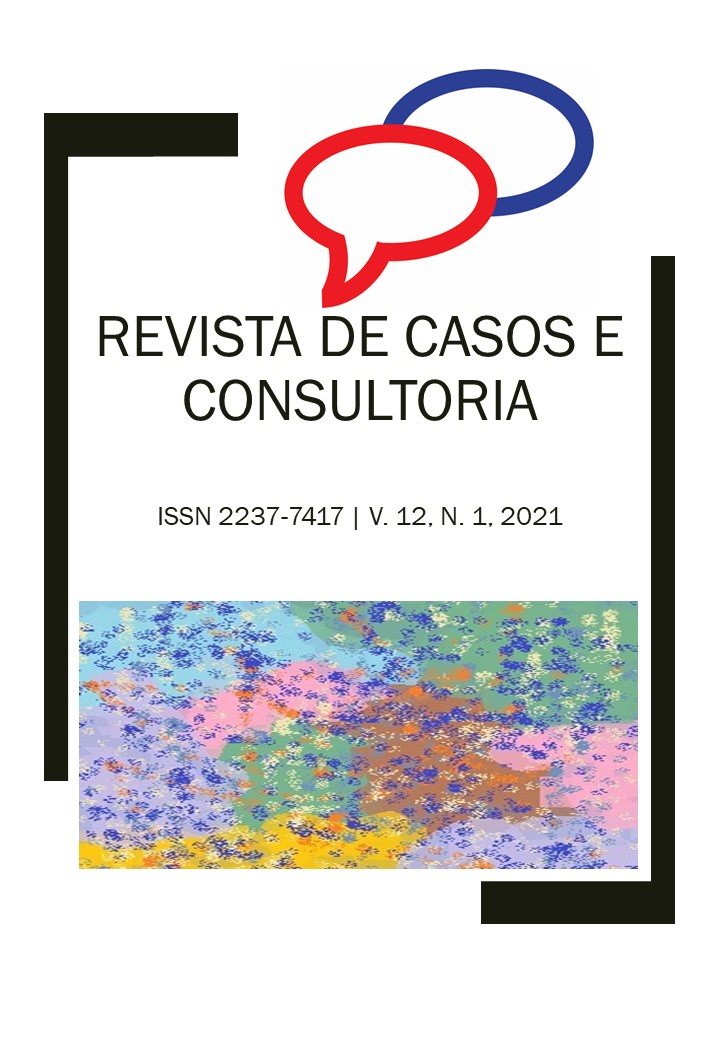Effects of high-flow nasal cannula in adult patients with COVID-19
Keywords:
Nasal cannula; COVID-19; Oxygen Therapy.Abstract
COVID-19 is an infectious disease spread through respiratory secretions and is responsible for the acute respiratory syndrome that has affected countless people worldwide. High-flow nasal oxygen therapy has been widely used to reduce the pneumofunctional damage caused by the disease. This study aimed to evaluate the effects of high-flow nasal cannula in patients with COVID-19. This is an integrative, descriptive, exploratory review, carried out based on a search for articles in the Scientific Electronic Library Online (SCIELO), Virtual Health Library (BVS) and National Library of Medicine (PubMed) virtual databases, using the descriptors “Nasal cannula”, “COVID-19” and “Oxygen Therapy” associated with the Boolean operator “AND” for greater specificity in the literature review. In order to be included in the study, the articles had to be original, address the use of high-flow nasal cannula in adult patients with COVID-19, have been published in the last 5 years and be available in full. After applying the inclusion criteria, a total of 7 articles were selected. The included studies showed that the high-flow nasal cannula is an efficient means of ventilatory support in patients with COVID-19 and can be considered a safe form of treatment. In conclusion, it was possible to observe that the treatment performed through the high-flow nasal cannula is associated with a smaller number of intubations and shorter hospital stay.
Downloads
References
BONNET, Nicolas et al. High flow nasal oxygen therapy to avoid invasive mechanical ventilation in SARS-CoV-2 pneumonia: a retrospective study. Ann Intensive Care, vol. 11, 37, 2021. Disponível em: https://www.ncbi.nlm.nih.gov/pmc/articles/PMC7910764/. Acesso em: 14 set. 2021.
CAMPOS, Nataly Gurgel; COSTA, Rayana Fialho. Alterações pulmonares causadas pelo novo Coronavírus (COVID-19) e o uso da ventilação mecânica invasiva. Journal of Health & Biological Sciences, vol. 8, n.1, 2021. Disponível em: https://periodicos.unichristus.edu.br/jhbs/article/view/3185. Acesso em: 06 ago. 2021.
CHAVARRIA, Adrian Palacios et al. High-flow nasal cannula therapy for hypoxemic respiratory failure in patients with COVID-19. Therapeutic advances in infectious disease, vol. 8, 2021. Disponível em: https://www.ncbi.nlm.nih.gov/pmc/articles/PMC8419547/. Acesso em: 14 set. 2021.
DANTAS, Lívia Carolina de Souza et al. Manejo ventilatório no tratamento de pacientes com covid-19 em unidades hospitalares. Ações e experiências para o enfrentamento da pandemia de COVID-19. Atena Editora, vol. 3. 1 ed. P. 189-202, 2021. Disponível em: https://www.atenaeditora.com.br/post-artigo/52718. Acesso em: 10 ago. 2021.
FARIAS, Lucas De Pádua G. et al. Thoracic tomographic manifestations in symptomatic respiratory patients with COVID-19. Radiologia Brasileira [online], vol. 53, n. 4, pp. 255-261, 2020. Disponível em: https://doi.org/10.1590/0100-3984.2020.0030. Acesso em: 10 ago. 2021.
FRANÇA, B. C. et al. Principais sinais clínicos apresentados por pacientes Covid positivo. Revista de Casos e Consultoria, vol. 12, n. 1, p. e25702, 2021. Disponível em: https://periodicos.ufrn.br/casoseconsultoria/article/view/25702. Acesso em: 10 set. 2021.
HU, Ming et al. Application of high-flow nasal cannula in hypoxemic patients with COVID-19: a retrospective cohort study. BMC Pulmonary Medicine, vol. 20, 324, 2020. Disponível em: https://doi.org/10.1186/s12890-020-01354-w. Acesso em: 15 set. 2021.
MELLADO-ARTIGAS, Ricard et al. High-flow nasal oxygen in patients with COVID-19-associated acute respiratory failure. Critical Care, vol. 25, 58. Fev. 2021. Disponível em: https://doi.org/10.1186/s13054-021-03469-w. Acesso em: 13 set. 2021.
PIRES BRITO, S. B. et al. Pandemia da COVID-19: o maior desafio do século XXI. Vigilancia Sanitaria Em Debate, vol. 8, n. 2, p. 54-63. Abr. 2020. Disponível em: https://visaemdebate.incqs.fiocruz.br/index.php/visaemdebate/article/view/1531. Acesso em: 10 ago. 2021.
SANCHEZ VALVERDE, Alex J. et al. COVID-19: fisiopatología, historia natural y diagnóstico. Revista Eugenio Espejo, vol. 15, n. 2, p. 98-114, 2021. Disponível em: https://doi.org/10.37135/ee.04.11.13. Acesso em: 06 ago. 2021.
SAYAN, Ismet et al. Impact of HFNC application on mortality and intensive care length of stay in acute respiratory failure secondary to COVID-19 pneumonia. Heart & Lung: The Journal of Cardiopulmonary and Acute Care, vol 50, 425-429, 2021. Disponível em: https://doi.org/10.1016/j.hrtlng.2021.02.009. Acesso em: 15 set. 2021.
SUFFREDINI, D. A.; ALLISON, M. G. A Rationale for Use of High Flow Nasal Cannula for Select Patients With Suspected or Confirmed Severe Acute Respiratory Syndrome Coronavirus-2 Infection. Journal of Intensive Care Medicine, vol. 36, p. 9–17, 2020. Disponível em: https://journals.sagepub.com/doi/10.1177/0885066620956630. Acesso em: 09 ago. 2021.
TENG, Xiao-Bao, et al. The value of high-flow nasal cannula oxygen therapy in treating novel coronavirus pneumonia. European journal of clinical investigation, vol. 51, 3, 2020. Disponível em: https://www.ncbi.nlm.nih.gov/pmc/articles/PMC7645937/. Acesso em: 19 set. 2021.
WHITTLE, Jessica S. et al. Respiratory Support for Adult Patients with COVID-19. Journal of the American College of Emergency Physicians Open, vol.1, n.2, p. 95-101, 2020. Disponível em: https://onlinelibrary.wiley.com/doi/10.1002/emp2.12071. Acesso em: 09 ago. 2021.
XIA, Jingen et al. High-Flow Nasal Oxygen in Coronavirus Disease 2019 Patients With Acute Hypoxemic Respiratory Failure: A Multicenter, Retrospective Cohort Study. Critical Care Medicine, vol. 48, p. 1079-1086, 2020. Disponível em: https://www.ncbi.nlm.nih.gov/pmc/articles/PMC7467042/. Acesso em: 19 set. 2021.

 Português (Brasil)
Português (Brasil) English
English Español (España)
Español (España)